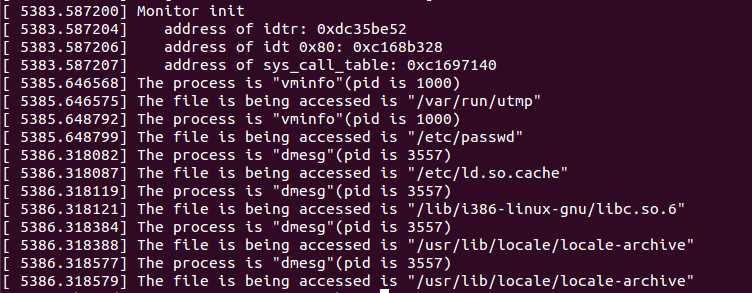标签:
上一章,我们获取了系统调用表的地址,这里我们来搞点所谓“截获”的事情。所谓“截获”即是将系统调用表里的地址指向我们自己写的一个函数,系统调用先执行我们自己写的函数,处理完后,再返回原来系统调用的执行函数。
还是先贴代码吧。
modu.c

#include<linux/init.h>
#include<linux/module.h>
#include<linux/moduleparam.h>
#include<linux/unistd.h>
#include<linux/sched.h>
#include<linux/syscalls.h>
#include<linux/string.h>
#include<linux/fs.h>
#include<linux/fdtable.h>
#include<linux/uaccess.h>
#include<linux/rtc.h>
MODULE_LICENSE("Dual BSD/GPL");
#define _DEBUG
#ifdef _DEBUG
#define kprintk(fmt,args...) printk(KERN_ALERT fmt,##args)
#define kprintf(fmt,args...) printf(fmt,##args)
#define kperror(str) perror(str)
#else
#define kprintk
#define kprintf
#define kperror
#endif
/*Function declaration*/
long * get_sys_call_table(void);
unsigned int close_cr(void);
void open_cr(unsigned int oldval);
void start_hook(void);
asmlinkage long (*orig_open)(char __user *filename, int flags, int mode);
long * g_sys_call_table = NULL; //save address of sys_call_table
long g_old_sys_open = 0; //save old address of sys_open
long g_oldcr0 = 0; //save address of cr0
struct _idtr{
unsigned short limit;
unsigned int base;
}__attribute__((packed));
struct _idt_descriptor{
unsigned short offset_low;
unsigned short sel;
unsigned char none,flags;
unsigned short offset_high;
}__attribute__((packed));
unsigned int close_cr(void){
unsigned int cr0 = 0;
unsigned int ret;
asm volatile("movl %%cr0,%%eax":"=a"(cr0));
ret = cr0;
cr0 &= 0xfffeffff;
asm volatile("movl %%eax,%%cr0"::"a"(cr0));
return ret;
}
void open_cr(unsigned int oldval){
asm volatile("movl %%eax,%%cr0"::"a"(oldval));
}
/*Get the address of sys_call_table*/
long * get_sys_call_table(void){
struct _idt_descriptor * idt;
struct _idtr idtr;
unsigned int sys_call_off;
int sys_call_table=0;
unsigned char* p;
int i;
asm("sidt %0":"=m"(idtr));
kprintk(" address of idtr: 0x%x\n",(unsigned int)&idtr);
idt=(struct _idt_descriptor *)(idtr.base+8*0x80);
sys_call_off=((unsigned int)(idt->offset_high<<16)|(unsigned int)idt->offset_low);
kprintk(" address of idt 0x80: 0x%x\n",sys_call_off);
p=(unsigned char *)sys_call_off;
for(i=0;i<100;i++){
if(p[i]==0xff&&p[i+1]==0x14&&p[i+2]==0x85){
sys_call_table=*(int*)((int)p+i+3);
kprintk(" address of sys_call_table: 0x%x\n",sys_call_table);
return (long*)sys_call_table;
}
}
return 0;
}
//My own sys_open
asmlinkage long my_sys_open(char * filename, int flags, int mode){
kprintk("The process is \"%s\"(pid is %i)\n",current->comm,current->pid);
kprintk("The file is being accessed is \"%s\"\n",filename);
return orig_open(filename,flags,mode);
}
void start_hook(void){
g_sys_call_table = get_sys_call_table();
if(!g_sys_call_table){
kprintk("Get sys_call_table error!\n");
return;
}
if(g_sys_call_table[__NR_close] != (unsigned long)sys_close){
kprintk("Incorrect sys_call_table address!\n");
return;
}
g_old_sys_open = g_sys_call_table[__NR_open];
orig_open = (long(*)(char *, int, int))g_sys_call_table[__NR_open];
g_oldcr0=close_cr();
g_sys_call_table[__NR_open] = my_sys_open;
open_cr(g_oldcr0);
}
int monitor_init(void){
kprintk("Monitor init\n");
start_hook();
return 0;
}
void monitor_exit(void){
if(g_sys_call_table && g_old_sys_open){
g_oldcr0 = close_cr();
g_sys_call_table[__NR_open] = g_old_sys_open;
open_cr(g_oldcr0);
}
kprintk("Monitor exit\n");
}
module_init(monitor_init);
module_exit(monitor_exit);
Makefile文件和上一节是一样的,这里就不贴了。同样按照上一节的方法,将modu.c编译,然后加载到内核中。
加载成功后,执行“dmesg”,看到的系统日志如图。

如果稍微晚一点执行“dmesg”,系统日志就可能被截获open调用打印的信息刷屏了,因为open系统调用实在是被调用的太多了。
可以执行“lsmod”,查看当前系统中含有的模块,可以找到我们刚刚加载的modu。
ok,接下来解释一下原理。
之前也有解释过,“截获”的过程即是:修改系统调用表中调用函数的地址,将其执行我们自己实现的函数,再在我们自己的函数中完成我们想做的事情后,在返回到原来的系统调用执行流程中。
代码里面的这个函数asmlinkage long my_sys_open(char * filename, int flags, int mode),就是我们自己实现的调用函数,注意这里的形参是参考系统原有的open调用函数的原型来了,必须是这个样子。每种系统调用的原型是什么样子,可以自行百度。
在my_sys_open()中,我们打印了当前是哪个进程在访问(进程名和进程号的信息),访问的是哪个文件(文件的绝对路径),打印完后跳转到原来的系统调用函数。
在模块初始化的过程中,执行start_hook()函数。在start_hook()函数中,先获得系统调用表的地址,将系统调用表中的原有地址保存下来,再将my_sys_open()函数的地址赋到系统调用表中。
注意修改系统调用表时,由于内核中的很多东西,比如这里的系统调用表sys_call_table是只读的,我们需要修改一下权限才能修改。由于控制寄存器CR0的第16位若置位,则表示禁止系统进程写那些只有只读权限的文件,所以我们在修改系统调用表sys_call_table之前先将CR0的第16位清零,在修改完后再恢复置位就好了。如代码里的close_cr()函数,即是将CR0第16位清零,open_cr()函数是将CR0第16位恢复。
最后在卸载modu模块的时候,将系统调用表的内容还原就OK了。
标签:
原文地址:http://www.cnblogs.com/lxw315/p/4773566.html